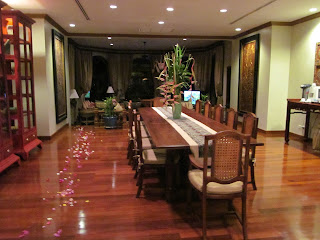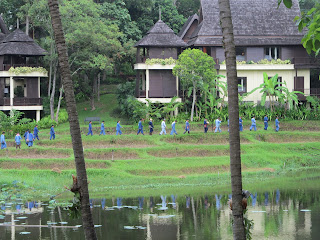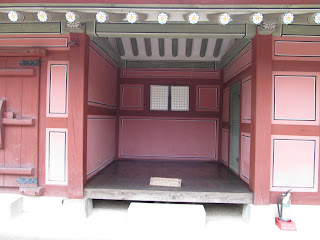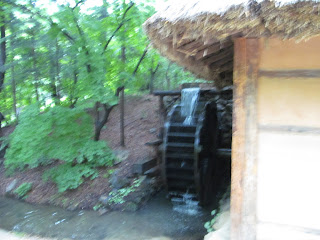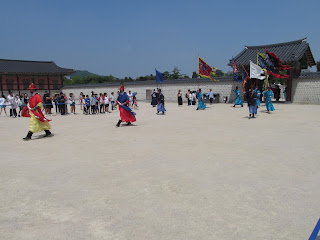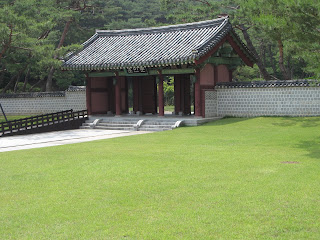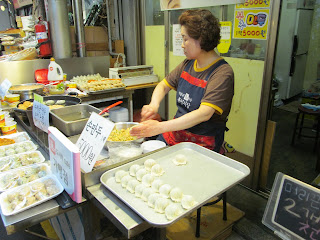50th Anniversary Trip
27 May - 11 June 2017
To celebrate our 50th
Wedding Anniversary, we decided to return to the Four Seasons Resort in
Chiang Mai, Thailand. As this was our
third stay at this hotel, we had no plans, and did not leave the resort for the
entire time we were there. After a week there, we traveled to Seoul,
South Korea for a week's sightseeing.
Saturday 27 May &
Sunday 28 May
– We flew Korean Airlines in Business Class from DFW to Seoul where we
connected with another Korean Airlines flight to Chiang Mai, Thailand. We
landed in Chiang Mai at 10:15pm Sunday. Once inside the terminal, we joined the
line for Immigration. With a half-dozen agents working, it moved fairly
quickly. We got our luggage from the carousel and went outside to meet our
driver. Once inside, the car, we had about a 30 minute drive to the hotel. Upon
arrival at Four Seasons Resort, we were greeted with tea. Our photo was
made with us sitting in a golf cart especially decorated for us and our
anniversary; Janet received a bouquet of orchids. Because the room we requested
was not available, we were upgraded and booked in Residence 21. Inside the
door, a pathway of flower petals led to the bed where a heart and 50th done in
red petals decorated the spread. More petals formed a pathway to the bathtub
with a petal-decorated rim. All decorations were compliments of Marina, the
lady welcoming us. The huge residence had living and dining areas as well as a
powder room, bedroom and bathroom, another sitting area. Outside was a private
plunge pool off the patio. We also received wine and a gift.
The huge residence had living and dining areas as well as a powder room, bedroom and bathroom, another sitting area. Outside was a private plunge pool off the patio.
Monday 29 May - We called for a buggy
to take us to breakfast in "The Cooking School," where an extensive
buffet tempted us. During our meal, we watched a couple create floral offerings
and floral ornaments. After breakfast, we walked back up to the "Reception
Area" to talk to Kris, the concierge, about our Anniversary Dinner on
Thursday. While waiting, we visited with Danny, the manager, who made us feel
very welcome. We got a buggy ride back to the room. We heard "music,"
a gong and cymbals about 5:00. Soon a parade of workers marched in, lined up
facing the lobby area, and sang a song. Then they marched out the opposite
direction. We learned this is to thank everyone for working and for the
fertility of the farm.
Although we saw the water buffalos plod toward the lobby area about
4:45. We called and made reservations in "Terraces" for dinner at
6:15. We sat on the terrace at the restaurant and enjoyed watching the
lamplighter as he meandered the rice paddies taking his flame from one oil
burner topped pole to another. As it grew darker, the lights formed yellow dots
in the rice paddies below.
The bugs were really annoying by the time we left.
Tuesday 30 May – At breakfast, Frame,
the manager, not only remembered our name but also that we wanted orange juice
and coffee. After breakfast, we met the two water buffalo while walking back up
to the "Concierge" desk to leave the menu for Thursday night's dinner
for Kris to pick up. We got a buggy back to the room. We ordered lunch from
room service. At 12:45, a buggy arrived to take us for our massages. The
masseuses worked their magic and really relaxed us. The buggy dropped us back
at the room shortly before 3:00. About 3:20, the rain began. The bottom dropped out and it
poured. There was another workers' parade complete with gong and cymbals again
today. We had a reservation in "Terraces" for 6:45. There were less
annoying bugs in the restaurant tonight, but they did not have all the lights
on. We were amused that numerous lizards/geckos had "prime dining spots"
on one of the upper beams. It was after 8:00 when we returned to the room via
buggy. We had seen lightning while eating and heard more and more thunder after
we got back inside the room. Before long, it began raining.
Wednesday
31 May
- As the buggy passed the lobby area on the way to breakfast, we were greeted
by both Kris, the concierge, and Danny. We hadn't been back in the room too
long before housekeeping arrived, so we went to the porch. While we were
outside, the porch sweepers arrived, and we indicated they could do their job.
Lots of bowing. We realized someone had come much earlier and cleaned the pool
as there were no leaves in it from yesterday's rainstorm. We called for a buggy
to take us to "Terraces" for lunch. Rice farmers worked in the
paddies, and we watched them as we ate. About 2:30, it began to rain, and the
farmers made it to cover before the bottom fell out. After about 30 minutes of
hard rain, it slowed to a sprinkle and then quit completely. there was another
farmers' parade and lighting of the fire pot. We enjoyed dinner in "Terraces.”
Thursday 1 June - Our 50th Wedding
Anniversary - Imagine our surprise when Kris, head concierge, arrived to drive
us to breakfast. After breakfast, we returned to the room to relax. Room
service delivered lunch about noon. About 3:00, it thundered; we came inside;
it rained hard for 30 to 45 minutes and then tapered off. It rained on our
wedding day, too. At 6:50, our escort arrived to walk us to the Yoga Bann for
our private dinner. The area was decorated with colorful umbrellas, hanging
lanterns, candles and flowers. Yellow petals spelled out "Happy 50th
Anniversary" across the floor. Our table for two sat under the pavilion,
so the sprinkling rain, which stopped before 8:00, didn't affect us. We made
some photos, enjoyed a welcome drink and sat down to be served a delicious
menu: rice noodle rolls with prawns; forest mushroom soup with truffle oil;
seared sea scallops with potato puree, asparagus tips and balsamic reduction;
lime sherbet; roasted beef filet with goat cheese ravioli and shallot
bordelaise sauce; potato crusted salmon fillet with artichoke fricassee; hot
chocolate melt with vanilla ice cream. Golf, our private waiter, brought each
course to the table, refilled drinks and was most attentive. Just when we thought
we couldn't eat another bite, a member of the food and beverage staff brought a
plate of mango sticky rice with an anniversary greeting piped on the plate; we
asked to have it sent to the room. All during our time at the pavilion, Ms, Fada,
a young lady, played music on a hammered dulcimer. We also launched a Krathong,
a round boat made from banana leaves and flowers with a burning candle and joss
sticks in it. This was to bring us luck and make our wishes come true. About
10:00, we were escorted back to our room where we found a congratulatory card
and a bouquet of flowers. What an amazing evening!
Friday 2 June - Just another relaxing
day in the resort. At breakfast. Chef
Stephane Calvert, who is French, stopped by our table. He asked about last
night's dinner and then told us a little about his career. He also invited us
to visit his herb garden. The afternoon’s massages were just as wonderful as
the previous ones. We heard rain during the massages but there was none as a
buggy returned us to the room. It poured rain about 4:00. When it stopped, we
called for a buggy to take us to "Terraces" for a late lunch.
Saturday 3 June - A buggy took us to
breakfast where the staff escorted us to "our same table" and ordered
our pancakes without our asking. Our table was in front of the area where a man
and a woman create crafts. Up until today those crafts have used flowers and
reeds to create bracelets, rings, head ornaments, crabs, fish and even
"roses" made by folding the reed, as some do with ribbon. Today the
craft was paper cutting. Multicolored sheets of tissue paper were stacked,
folded and then cut like snowflakes to form lacy, elongated, round hanging
ornaments.
Watching the artisan at work was fascinating. Once again, the chef
stopped to visit. After breakfast, we
returned to the shop area. The water buffalo were on display, so we made some
photos of the resort's mascots.
We returned to the room. Someone from the food
service staff brought a framed photograph from Thursday night's dinner as a
gift from them. We ordered room service and had the mango sticky rice from
Thursday night for dessert. We had reservations in "Terraces" for
dinner.
Sunday 4 June - We returned to the room from breakfast to
find housekeeping hard at work. We waited on the porch for them to finish. Then
it was time to go inside and pack. We had almost everything packed around
11:00. Today's rain came earlier and harder; it began about 11:30 and poured
from noon until almost 1:00. When it slacked off, we called for a buggy to take
us to "Terraces" for lunch. We waded out to the buggy and from the
buggy into the restaurant; standing water covered most surfaces. We got the
last table in the restaurant. By 2:00, the rain was over and the restaurant 3/4
empty. We spent the afternoon relaxing in the room. The buggy driver arrived at
6:30. He dropped us at "Terraces" and took the bags to the lobby.
Once again, maybe for the last time ever, we enjoyed dinner on the open deck
overlooking the rice fields. Although there were people in the adjacent bar, we
were the only diners in the restaurant. When it came time for dessert, we were
informed "the chef make you a special dessert." We got mango sticky
rice and coconut ice cream. The sous chef himself came to the table to wish us
well and to say that he had combined the traditional Thai dessert with the ice
cream he knew we liked. As we left the restaurant, the entire staff was grouped
to tell us good-bye and "until next time." A buggy arrived to take us
to the lobby area for check-out. We settled in to wait for the airport transfer
scheduled at 9:00, but they called the driver to come earlier. Meanwhile, we
visited with Danny, one of the managers. The car arrived at 8:30 for the
half-hour-drive to the airport. Once there, we checked in for KE668 departing
for Seoul at 11:53. After checking in, a Korean Air employee escorted us across
the lobby, up an escalator, through Security, and into the "Coral Lounge"
to wait until boarding. We took off about midnight.
Monday 5 June - Another time change,
Korea is 14 hours ahead of CDT, whereas Thailand was 12. After landing at
Incheon about 7:00a.m., we had to queue for Immigration. That took a while and
our bags were the last two remaining from our flight when we got to Baggage
Claim. We spent about an hour between deplaning and exiting Customs to meet the
"Four Seasons" representative who escorted us to the car. Mr. Kim,
our driver, told us some facts and pointed out some sights on the drive to the
hotel; it took about an hour. We were not too alert. We saw lots of bridges,
the green-domed Parliament, and acres of high-rise apartment buildings before
arriving at the "Four Seasons - Seoul." We were met on the driveway
and escorted directly to room 2622 for private check in. We were upgraded to a
suite, and even had a congratulatory Anniversary cake. In our suite, a hallway
led past doorways and an in-room bar, complete with sink, to the main area. A
curved wall composed of 5 floor-to-ceiling windows provided a view across the
city to a mountain; electronically controlled shades could cover the windows:
one provided privacy but allowed light while an additional shade provided
darkness---all at the touch of a button. A large corner sofa with a round
coffee table in front provided a comfortable place for enjoying the view. A
desk with a TV above it completed that portion of the suite. A king sized bed
with shelving and tables on each side dominated the sleeping area. Seating
provided by two chairs with a table between was complemented with a padded
bench at the foot of the bed. A large TV above a chest dominated one wall. The
long bathroom paralleled the hallway and contained a soaking tub across from
double sinks in one area. A third and smaller TV lurked behind a mirror. A large walk-in shower and a separate toilet
room---complete with electronic Korean-style toilet and its own
sink---completed the bathroom area. A walk in closet was at the end of the
bathroom. A sliding door could close off the bathroom from the bedroom; other
sliding doors closed off the toilet room from the hallway and the bathroom. Two
additional sliding doors separated the closet from the bathroom and the front
hall. We had access to the "Executive Club Lounge" for some
breakfast, afternoon tea and hors d’oeuvres each day.
Tuesday 6 June - We met our Private
Seoul City Tour at 1:00. We met Sunny Yang, our guide, went back to the room for
umbrellas, and were on our way. We first went to Changdeokgung Palace
but found out the time for the English tour of the "Secret Garden"
had been changed to 2:30. Sunny took us to Jogye Temple instead. We
enjoyed the walk through of the Buddhist Temple and made some photos. Three
huge Buddhas dominate the interior.
Then we went to a Hanock area to see
the exteriors of some of the old houses.
Today was a holiday, like
"Memorial or Veterans Day" in the US; it honors those killed in the
Korean War. Lots of families were out and about and many young ladies wore
"Han Bok," traditional dress. We returned to Changdedeokgung
Palace, which was constructed in 1405 as a secondary palace for the Joseon
Dynasty, and saw some of the public areas before joining the guided tour of the
so-called Secret Garden or Forbidden Garden. It got its name by
being for the exclusive use of the King or anyone he deemed worthy of allowing
inside. We had to be on a tour to see it
and couldn't get ahead of the guide even though Sunny gave us our tour. Stepping
stones in one area were for training the Crown Prince on how to walk as a King
must walk: stride along; head up; shoulders thrust backward; hands clasped
behind back. One area was created with a number of up-and-down hills to teach
the palanquin chair bearers how to maintain a steady and level ride for the
Queen. Another interesting pavilion had served as the King's library. At the end, we left via the "long
life" gate and didn't climb the hundred or so steps to the exit. After
leaving, we saw more of the palace and learned how some areas had floors heated
by charcoal. The Palace's buildings are reminiscent of China's "Forbidden
City" and are intricately painted. Japanese troops destroyed the palace in
the 1590s, but it was rebuilt in 1610 to serve as the main palace for about 270
years. Only royal palaces could be painted; death awaited anyone else who
painted his home. We returned to the hotel about 5:00.
Wednesday 7 June - We met Sunny at 9:00
for today's tour. Leaving the hotel, we drove to Suwon. There was a big traffic
tie up on the way and the drive took a little more than an hour. Our first stop
was Suwon Hwasung Fortress where we learned about it's construction and
reconstruction based on original plans. Originally built in the 1790s, it was
intended to serve as the capital.
We visited Hwasung Palace. Much smaller than the palace we saw yesterday, we enjoyed it more. The king's and the queen's areas were more clearly defined for us and we saw the tiny rooms in the back for the eunuchs and the maidservants. We were able to see more clearly how the under-the-floor heating worked using charcoal to heat channels and then vent the fumes through outside chimneys. We finally understood that the floor must be tightly sealed to prevent the toxic fumes from entering the rooms. We saw a round metal sundial that not only told the time but also the season. In one display was a lattice bamboo tube, which was held while sleeping to provide air circulation; they called it "bamboo ice." There were also latticework bamboo arm bands and a lattice work bamboo vest to be worn under clothing to provide air circulation during hot weather. Between the men's and the women's areas there was a small door so that the queen could look at the number of shoes outside the men's area and know how many visitors would be dining with the king. A diorama showed a feast with each noble eating at his own table.
After touring the palace, we went for a
Korean barbecue lunch at Kabojung. We opted for Korean beef, which we
are told is identified and tracked from grower to consumer and chose beef ribs,
which were grilled at the table on a gas-fired, charcoal brazier, a pit in the
center of the table with a removable grill on top. A heavy lid covered the pit
when not in use. Meat, a rib with a thin strip of meat attached, was brought to
the table, placed on the grill using a long for, and unrolled. After turning,
scissors were used to snip the strip into large-bite-sized-pieces. After 2 ribs
were cooked, a special handle was used to remove the hot grill, place it in a
stack across the aisle, and add a clean grill. Because Korean dishes are served
hot, utensils are metal---usually brass; we were given brass chopsticks and a
brass long-handled spoon. Of course, we asked for a fork. Dozens of dishes of
vegetables and condiments filled the table; we stuffed ourselves. A cinnamon
flavored plum tea finished the meal. During the meal, a man often walked the
aisle carrying a rectangular metal bucket of hot charcoal, which radiated heat,
from outside to inside and back. After lunch we went to Korean Folk Village,
an open-air area showing life in the Joseon Dynasty. Various buildings,
especially constructed for this village, demonstrate the architecture and
lifestyle of low, middle and upper class residents in the South, Middle and
North of the country. Various building materials were showcased. One area
contained mockups showing different roofing materials: slate, straw, tile,
bark, etc., while another displayed actual buildings of stone, wood, thatch,
etc. Implements and furnishings completed the presentation, while some craft
demonstrations were offered: a pottery studio; a man making straw shoes; a
beggar. In another area a woman unwound silk from a cocoon---there are 1500+
meters on each---onto a reel. The governor was seated on his dais and various
torture instruments occupied the space below him. While we were there a
percussion group performed using traditional instruments. Mills, crop
plantings, and animals, chickens, horses, cattle, added to the authenticity. A
Jindo, a Korean dog from the island of the same name, occupied a special
kennel; nearby a small sty held a huge "Black Korean Pig." A walk
through a museum arranged to show life according to the way a person ages
topped off the visit. Although it drizzled off and on while we were there, we
popped open umbrellas and slogged through the puddles.
The drive back to Seoul
took less time and we arrived at the hotel about 4:30.
Thursday 8 June - The morning's weather
was dry, brighter and almost clear---hazy. At 1:45, we met Sunny in the lobby
for our afternoon's tour. Leaving the hotel, we went to Gyeongbokgung Palace
for the "Changing of the Guard" reenactment. Three loud bangs on
a huge drum followed by three notes from a horn signaled the beginning; the
same signal ended the ceremony. Actors in colorful costumes carrying ancient
weapons as well as flag bearers and musicians added to the short performance.
Afterwards, we toured the palace, first built in 1396 as the main residence of Joseon monarchs. Burned by the Japanese in 1592, it was rebuilt in 1867 by the father of the man who became king when the royal line ran out; it was then destroyed again by the Japanese and is under reconstruction today.l It is much more "Forbidden City" like than the previous ones we saw as it is constructed according to fung shui; the others were constructed in harmony with nature.
We skipped the museums but made a photo of the pagoda. We learned that
the king contracted with Thomas Edison, built a power plant, and that this
palace had electricity in 1887. It was the first electrification in Asia. That
did not prevent the Japanese from raping, murdering and dismembering the queen
before burning her body and scattering her ashes; the king never returned to
this palace after that but spent many years in the Russian Embassy.
Leaving the
palace area, we made a photo of the so-called Blue House, the
Presidential home.
Our next stop was in Bukchon Hanok Village where we
planned to visit Bukchon Hang Sang Soo Embroidery. A note taped to the
door indicated that it was closed for renovation. Sunny called and found a
store on Insadong Street that sold the embroideries. On the way back to the
car, we stopped at Dong-lim Knot Workshop, the shop of a master Korean
knot maker, where we watched knot making instruction. Our next stop was on
Insadong where we went to Kukjae Embroidery, the store selling
embroideries. We then drove to Dongdaemun Complex, the textile market, a
multi-story building selling everything textile, including buttons, ribbons,
lace, buckles, and all other notions.
We returned to the hotel about 5:30.
Friday 9 June – We met Sunny at 9:00
and drove from the hotel and crossed the river into the South Side of Seoul.
When we passed the world's second tallest building, Sunny showed us fireworks
photos on her phone; they where made at the Grand Opening. We drove freeways to
Icheon Pottery Village, and it took about an hour. Upon arrival, we went to Hanchung,
the workshop of a master potter. We watched as he turned a block of clay
into a vessel. His massive hands shaped and molded the blob as the wheel spun.
He also showed how inlay was done as well as the freehanded etching of design
into the surface. We then saw the clay kiln outside and firing temperatures and
firing times were explained. That kiln is only used once a year because the
neighbors complain. They have another gas fired kiln on the outskirts of the
town. The shop contained many beautiful examples of their craftsmanship.
From
the pottery studio, we visited the Municipal Museum, which contained an
excellent display of various artifacts and styles of pottery from the local
area. With local history interwoven into the displays, we gained a better
understanding of the pottery industry in the area.
Our next stop was lunch at The
King's Rice House. First some appetizers were brought to the table and then
a set menu which centered around a big pot of hot rice---one for each person.
After the wooden cover was removed from the pot and the rice scooped into a
bowl, warm water was poured into the pot and the cover replaced; this would
form rice soup for later. The table was then laden with small dishes of meats,
fish, vegetables and other goodies to enjoy with the rice. Once again, we had
forks while Sunny and the driver had brass chopsticks. We all had long-handled
spoons. We ate for an hour or so. This area is famous for rice farming and we
enjoyed seeing many rice paddies. Other crops were grown in small plots, too.
After leaving, we drove to Yeoju to see the Tomb of King Sejong, who
reigned from 1418-1450. . Perhaps the greatest ruler of the Josean
Dynasty, King Sejong is credited with inventing Korean script as well as being
an inventor, so copies of many of his inventions were displayed: water clock;
rain gauge; sun dial; celestial globe; celestial calendar. We then walked
farther into the area and climbed a knoll to see the burial mound itself before
leaving. Stone animals and figures guard the mound area.
From there, it was
about an hour's drive back to Seoul. Because Seoul sits in a valley surrounded
by mountains, smog----and hence air quality---was terrible today. The ozone
level was high and visibility poor. At times, we could hardly see the mountains
from our windows..
Saturday 10 June - At 9:00, we met
Cindy, our guide for today; we had the same driver. Our first stop was Jongmyo,
the main shrine for the Korean Kings and Queens. Because we're over 70, we
got in free. We visited several areas inside the walled compound, a peaceful,
forested oasis in the city center. In the area where supplies for the
ceremonies were stored and where the king and crown prince purified themselves,
we watched a video of the ceremony performed annually to honor the royal
ancestry. Another room housed a display of the "Spirit Chamber." One
building showed the King dressed in the robes used for the rites. We then
walked to the Main Hall to see the long, impressive building housing the royal
ancestral tablets. These valuable tablets, which were carried by the Korean
King into exile in Russia, are only displayed once each year during the
ceremony. The ritual, a Confucian one with origins in China, is only performed
here. Therefore both the site and the ceremony earned UNESCO World Heritage
Designations.
After leaving the shrine, we drove across the city to Jeoldusan
Martyrs' Shrine. It was here that Roman Catholics were martyred by the
Korean government in 1867. A museum and memorial chapel were erected here in
1967, however the site lacked any sense of reverence, and we were told the
actual site of the martyrdom is under the parking lot and not the chapel.
Then
it was another drive across the city to Tong In Market, where we
wandered through as Cindy identified various products and explained their uses
in Korean cuisine. Both raw and prepared foods were available. Many in the
market were shopping while others were eating lunch using compartmented trays
to gather cooked foods from various stalls. There were a few stalls selling
souvenirs and other goods.
After meeting the driver, we drove to Insadong and
walked the entire length of the pedestrian area.
Sunday 11 June – Bright sunshine
greeted us as we opened the blinds; departure day was the sunniest and clearest
of the visit. The car was waiting when we got to the lobby at 7:00. The drive
to Incheon Airport took about 45 minutes. Once inside the terminal, we found
the check-in area. A first for us, check in for all Korean Air flights was by
class. Since we were flying Business Class, it didn’t take too long. Once
aboard, we found seats 8A & 8B and got settled for the 12+hour flight to
DFW. We landed early at 8:45 and had no problems at Immigration or Customs.
Garvin was waiting and we were home well before 10:00.
Thoughts on Korea
This was our first trip
to South Korea. We found a clean country and friendly, welcoming people.
Koreans appeared content and industrious. The country seems to have recovered
well from the Korean Conflict which devastated it and resulted in food
shortages for several years. Seoul was a safe city with a low crime rate.
Walking almost anywhere in the downtown area at any hour was supposed to be safe.
Like any city of 10 million people, traffic was bad. However, there were
dedicated bus lanes for public busses and a metro system. High rise apartment
buildings and office buildings dominate, and more are under construction.
Service charges are included in restaurants and tax on purchases in the asking
price. English is taught in the elementary schools. We did learn that five huge
conglomerates: Samsung; LG; Hyundai; Lotte; and Hynix; dominate the economy.
Minimum wage was 10,000 KW an hour, and they were protesting for 15,000KW.
Income tax brackets have a maximum of 38% and the government health care is
cheap. Health care cost is based on income. Housing can be very expensive:
location, location, location. We found it interesting that Korean women are obsessed
with beauty and having the perfect complexion and face. There is an ideal to be
achieved. Make-up is a huge seller in Korea and plastic surgeons provide some
facial reconstruction. Also, waiting in line or waiting one's turn is not a
part of their culture as they push ahead and in front. "Ladies first"
is also an unknown. Koreans appeared to
be proud of their past, their culture, and their traditions but eager to live
in the modern world.








